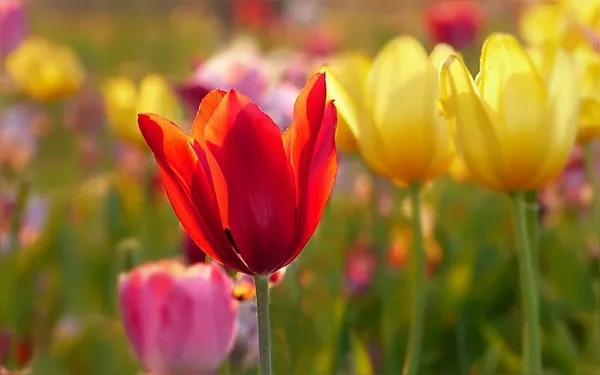Tulips, with their vibrant hues and elegant shapes, are a quintessential part of many gardens. From the moment their colorful blooms burst forth in spring, they captivate the eye and bring joy to those who behold them. However, as with all flowers, the spectacle of tulip blooms eventually fades, leaving gardeners with the task of managing the aftermath. In this article, we’ll explore the best practices for handling tulips after they have finished flowering, ensuring that your garden remains vibrant and healthy throughout the growing season.
Understanding the Tulip Life Cycle
Before delving into post-flowering care, it’s essential to understand the life cycle of tulips. Tulips are spring-blooming bulbs that go through distinct phases throughout the year.
1. Growth Phase: Tulip bulbs begin their growth cycle in late winter or early spring. As temperatures rise, the bulbs awaken from dormancy, sending up shoots that eventually produce leaves and flowers.
2. Flowering Phase: The flowering phase is the highlight of the tulip’s life cycle. Depending on the variety, tulips bloom from early to late spring, displaying their colorful petals in a breathtaking array of hues.
3. Post-Flowering Phase: After the blooms have faded, tulips enter a period of dormancy. During this time, the plant focuses its energy on replenishing its bulb for the next growing season.
Post-Flowering Care Tips
Once the tulip blooms have withered and the petals have fallen, it’s time to transition into post-flowering care. Proper care during this phase is crucial for the health and vitality of the bulbs. Here are some essential tips:
1. Deadheading: As tulip blooms fade, it’s essential to deadhead them promptly. Deadheading involves removing the spent flowers before they have a chance to go to seed. This not only improves the aesthetic appeal of the plant but also prevents the tulip from expending energy on seed production. To deadhead tulips, simply snip off the faded flowers with clean, sharp scissors or pruning shears.
2. Leave Foliage Intact: While it may be tempting to remove the foliage once the blooms have faded, it’s important to leave it intact. The leaves of the tulip plant continue to photosynthesize after flowering, helping to replenish the bulb’s energy reserves for the next growing season. Allow the foliage to yellow and wither naturally before removing it.
3. Watering and Feeding: During the post-flowering phase, tulip bulbs benefit from consistent moisture and nutrients. Continue to water the bulbs regularly, ensuring that the soil remains evenly moist but not waterlogged. Additionally, you can apply a balanced fertilizer to provide the bulbs with the necessary nutrients for healthy growth. Be sure to follow the manufacturer’s instructions regarding application rates and timing.
4. Avoid Disturbing the Bulbs: Tulip bulbs are sensitive to disturbance, especially during the post-flowering phase when they are replenishing their energy reserves. Avoid digging up or disturbing the bulbs during this time. If you need to transplant or divide tulip bulbs, it’s best to wait until after the foliage has withered and the bulbs have entered dormancy.
5. Mulching: Applying a layer of mulch around the base of the tulip plants can help conserve moisture, suppress weeds, and regulate soil temperature. Organic mulches, such as shredded bark or compost, are ideal for this purpose. Apply a layer of mulch to a depth of 2-3 inches, being careful not to smother the emerging foliage.
6. Planning for Next Year: As you care for your tulips after flowering, it’s also an opportune time to plan for the next growing season. Take note of which varieties performed well and which may need to be replaced. Consider adding new tulip varieties to your garden for a diverse and colorful display next spring.
Dealing with Tulip Bulbs After Flowering
Once the foliage has withered and turned yellow, indicating that the bulbs have entered dormancy, it’s time to address the bulbs themselves. Proper handling and storage of tulip bulbs after flowering are essential for ensuring their viability and longevity. Here’s what you need to know:
1. Lifting and Storing Bulbs: To lift tulip bulbs from the ground, carefully dig around the base of the plant, taking care not to damage the bulbs. Gently lift the bulbs from the soil and shake off any excess dirt. Inspect the bulbs for signs of damage or disease, discarding any that appear compromised. Allow the bulbs to dry in a well-ventilated area for a few days before storing them.
2. Cleaning and Preparing Bulbs: Once the bulbs have dried, remove any remaining foliage and trim the roots to tidy them up. Inspect the bulbs again for any signs of disease or rot, discarding any that show symptoms. Dust the bulbs with a fungicidal powder to prevent fungal infections during storage.
3. Storage Conditions: Tulip bulbs should be stored in a cool, dry place with good air circulation. A breathable storage container, such as a mesh bag or paper sack, is ideal for this purpose. Avoid storing bulbs in plastic bags or airtight containers, as this can promote mold and rot.
4. Monitoring for Pests and Disease: While in storage, periodically check the bulbs for signs of pests or disease. Look for any soft spots, mold growth, or unusual discoloration. If you notice any issues, separate the affected bulbs from the rest to prevent the spread of infection.
5. Planting Depth and Spacing: When it comes time to replant the tulip bulbs in the fall, be sure to plant them at the appropriate depth and spacing. Tulip bulbs should be planted at a depth of 6-8 inches and spaced 4-6 inches apart. Planting too shallowly or too closely together can result in weak growth and poor flowering.
Conclusion
By following these post-flowering care tips and handling your tulip bulbs with care, you can ensure that your garden remains vibrant and colorful year after year. With proper attention and maintenance, tulips will continue to delight and inspire for seasons to come.


